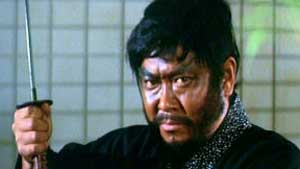 The Shadow Hunters (Kageguri, 1973), first half of a blood-drenched double-film, follows the ninja-hunting exploits of three samurai. The Shadow Hunters (Kageguri, 1973), first half of a blood-drenched double-film, follows the ninja-hunting exploits of three samurai.
In the late Tokugawa period, the Edo government is using spies from Iga province to cause the downfall of innocent provincial daimyo (lords). The shogun needs to claim the assets of fallen clans in order to boost the failing economies of Edo. The ninja hunters, jesting Sunlight or Tadanoshi Unui (Ryuhei Uchida) & gaunt Moonlight or Denosuke Kusaba (the underrated but very good Mikeo Narita), are led by a brooding fellow named Jubei Muroto (not to be confused with the standard ninja-film character Yagyu Jubei).
Jubei is the focal character of this film. The other two hunters will become the focal characters of part two Echo of destiny) Kagegari: Hoero taiho, 1972). Yujiro Ishihara as Jubei has clearly been influenced by the glowering, shadowed visage of Tomisaburo Wakayama.
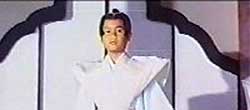 He seems, occasionally, to be doing a specific impersonation of Itto Ogami from the Babycart films (the Sword of Vengeance or Lone Wolf with Child series). This actually lends an endearing quality to the film; although low budget with minimal sets, there seems to be a degree of love & fun in the acting. Ishihara may well be a chambara fan who grew up to make those films himself! He seems, occasionally, to be doing a specific impersonation of Itto Ogami from the Babycart films (the Sword of Vengeance or Lone Wolf with Child series). This actually lends an endearing quality to the film; although low budget with minimal sets, there seems to be a degree of love & fun in the acting. Ishihara may well be a chambara fan who grew up to make those films himself!
There are some nice touches to the film. The hunters discover that they've been employed by a child daimyo. The youngster's samurai spirit impresses Jubei. In a flashback, we learn Jubei's own lord had been a mere child, too. Ninja create a situation whereby the government can demand that the child commit seppuku, with Jubei acting as the reluctant second. The pitiful bravery of the tiny lord disemboweling himself & the emotional state of Jubei who must cut off the boy's head are vividly captured.
In another effective sequence of violent tragedy, ninja murder an entire peasant clan & take their places, setting an elaborate trap for the three hunters.
Fighting scenes, which abound, range from sloppy to admirable. Sometimes the ninja are too clumsy to live up to their mythos in the slightest. One supposedly ferocious ninja uses kusari-kama (chain-&-scythe) too awkwardly to be convincing. On the other hand, Moonlight's yadame-jutsu (arrow deflecting art) is excellently staged. The chief villain is impressive at two-sword style, but is not otherwise an
interesting character.
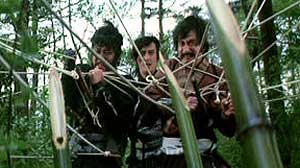 Characterization is a weak point in the film. Only Jubei is a fully realized figure, & though Yujiro Ishihara nearly carries the film effectively all by himself, it would be more entertaining if Sunlight the womanizer & the reticent, scarred Moonlight were better developed. Characterization is a weak point in the film. Only Jubei is a fully realized figure, & though Yujiro Ishihara nearly carries the film effectively all by himself, it would be more entertaining if Sunlight the womanizer & the reticent, scarred Moonlight were better developed.
Like the Babycart films, The Shadow Hunters is a take-off of a popular comic book. Unlike Babycart episodes, Hunters does not overcome the superficial nature of most comic book adventure. Although the film captures the goriness of the Babycarts, it lacks the excellent cinematography for quieter scenes. It captures none of the plot
complexity, historical relevance, or subtlety of character that makes the Babycarts more than just blood & guts.
Hunters is too simplistic, & sometimes illogical. For example, Sunlight gets a spear cast through his chest & out his back. Not only does he finish his fight scene as though uninjured, but two scenes later he turns up without a bloodstain or rip in his clothing. We're never informed how he miraculously healed himself, nor how Moonlight similarly recovers from a leg wound.
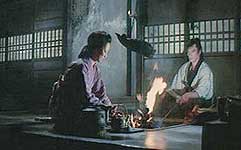 There are anachronisms in the film, too. Sunlight, pretending momentarily to respect women, calls himself "a natural born feminist." He's also into kissing, a Western mating ritual not practiced in Tokugawa Japan. The jazzy musical score sounds like it belongs to a 1970s police drama. There are anachronisms in the film, too. Sunlight, pretending momentarily to respect women, calls himself "a natural born feminist." He's also into kissing, a Western mating ritual not practiced in Tokugawa Japan. The jazzy musical score sounds like it belongs to a 1970s police drama.
And there are inconsistencies. The hunters travel by horses, yet we're to believe they're as stealthy as ninja, able to keep one step ahead of their silent foes. When the plot has no place for the horses, they conveniently vanish for a while.
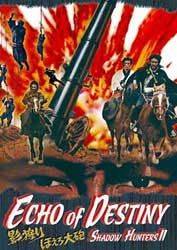 The contrived plot might have hung together with the help of a film editing genius, but The Shadow Hunters has no genius to it. It does have that kid-like enthusiasm for what chambara is. It's most reminiscent of the dubbed, re-edited American version of a Babycart film, Shogun Assassin gutted of plot, character, sensitivity, scenery, & simple logic. Despite its utter lack of finesse, The Shadow Hunters is enjoyable. The contrived plot might have hung together with the help of a film editing genius, but The Shadow Hunters has no genius to it. It does have that kid-like enthusiasm for what chambara is. It's most reminiscent of the dubbed, re-edited American version of a Babycart film, Shogun Assassin gutted of plot, character, sensitivity, scenery, & simple logic. Despite its utter lack of finesse, The Shadow Hunters is enjoyable.
Echoe of Destiny: Shadow Hunters II attempts to further increase the gore factor & the sexuality factor with such scenes as a battle against numerous buxom kunoichi, everyone stark naked.
Misogyny reaches a great height in several scenes, with the yuckiest yet jokey death reserved for Miya the cannon maker's daughter (Junko Natsu).
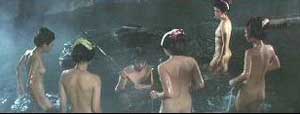 The sorts of dudes (who alas are numerous) who just love to see women cut to bits will like this episode best of the two. For the majority, however, it will not be the equal of the first film, & the first itself could've stood a lot of improvement. The sorts of dudes (who alas are numerous) who just love to see women cut to bits will like this episode best of the two. For the majority, however, it will not be the equal of the first film, & the first itself could've stood a lot of improvement.
Scenes of human cannon fodder are especially dull because swordfights should be up close & personal. Noise too often fills in for any actual intensity.
The three shadow-hunters are still pitted against ninjas of the Tokugawa government that have been sent to harrass rural daimyo.
It has, perhaps, a bigger dose of horrific humor than the first film, but it's harder to suspend disbelief when it gets downright cartoony. The springboard work of actors in ninja costumes is merely laughable.
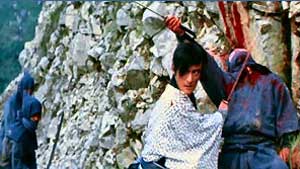 It sometimes reminded me of Chinese ninja movies which I personally find generally ridiculous in their inability to emulate the Japanese aesthetic of ninja correctly. It sometimes reminded me of Chinese ninja movies which I personally find generally ridiculous in their inability to emulate the Japanese aesthetic of ninja correctly.
Miko Narito as the ultimately pitiful Moonlight comes off best for character-interest & swordfights, but a lot of the action has insufficient context, & it is even more obvious than in the first film that the whole point is to put so much red paint on the screen that the cinema houses, declining in 1972, could present something much grosser than people were getting on television. Still, for all its faults, anything with horse-faced yet elegant Mikio Narita in it is bound to have worthwhile moments, as this does.
It was also the last film for Yujiro Ishihara, who created a wonderfully scruffy ninja-hunter figure, dark & brooding, a surprisingly dark farewell performance for an actor who had been a veritable matinee idol in the late 1950s & 1960s.
He was called the Brando of Japan, gorgeous & intense in his prime, fat & absurd toward the end. He also had a singing career that got him tagged the Japanese Elvis when still a young performer.
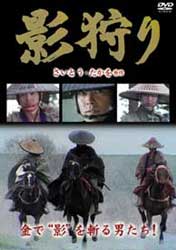 When he got too overweight for film roles, he continued to sing tearjerker folksongs that got him again compared to the older fatter Elvis doing gospel tunes, & like Elvis he managed not to live a long life. And also like Elvis, his film career, though wildly successful, was never in general considered top of the line stuff. When he got too overweight for film roles, he continued to sing tearjerker folksongs that got him again compared to the older fatter Elvis doing gospel tunes, & like Elvis he managed not to live a long life. And also like Elvis, his film career, though wildly successful, was never in general considered top of the line stuff.
He died relatively early from living a high life, his liver giving out in 1987, when he was only fifty-two years old. One-hundred seventy-thousand fans attended his funeral at Sojiji Temple in Yokohama, each receiving a bottle of Yujiro's favorite wine, as though the hosts hoped all the fans would die of liver disease equally early in life, as it was kind of like passing out loaded revolvers to honor someone who shot himself in the head.
Kagegari was remade as a telefilm (Shadow Hunters, 1992) starring Hiroaki Murakami who appeared with Jeff Fahey & Bridget Fonda in Iron Maze (1991); Renji Ishibashi who J-horror fans will remember of Miike's Audition (1999); plus Takeo Chii, Asao Sano, Shinjiro Ebara & the great Tetsura Tanba who is in the 1972 two-part version as well.
These cinematic adaptations were based on a popular & influential 1969 manga series by Takao Saito (who of course is not the same as Kurosawa's cinematographer of the same name). Saito-san's Gogo 13 manga series is available translated into English, adventures of the ultmate modern hitman.
copyright © by Paghat the Ratgirl
|
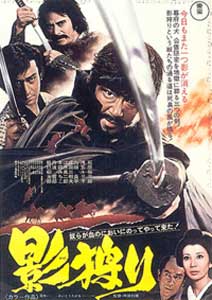

 He seems, occasionally, to be doing a specific impersonation of Itto Ogami from the Babycart films (the Sword of Vengeance or Lone Wolf with Child series). This actually lends an endearing quality to the film; although low budget with minimal sets, there seems to be a degree of love & fun in the acting. Ishihara may well be a chambara fan who grew up to make those films himself!
He seems, occasionally, to be doing a specific impersonation of Itto Ogami from the Babycart films (the Sword of Vengeance or Lone Wolf with Child series). This actually lends an endearing quality to the film; although low budget with minimal sets, there seems to be a degree of love & fun in the acting. Ishihara may well be a chambara fan who grew up to make those films himself! Characterization is a weak point in the film. Only Jubei is a fully realized figure, & though Yujiro Ishihara nearly carries the film effectively all by himself, it would be more entertaining if Sunlight the womanizer & the reticent, scarred Moonlight were better developed.
Characterization is a weak point in the film. Only Jubei is a fully realized figure, & though Yujiro Ishihara nearly carries the film effectively all by himself, it would be more entertaining if Sunlight the womanizer & the reticent, scarred Moonlight were better developed. There are anachronisms in the film, too. Sunlight, pretending momentarily to respect women, calls himself "a natural born feminist." He's also into kissing, a Western mating ritual not practiced in Tokugawa Japan. The jazzy musical score sounds like it belongs to a 1970s police drama.
There are anachronisms in the film, too. Sunlight, pretending momentarily to respect women, calls himself "a natural born feminist." He's also into kissing, a Western mating ritual not practiced in Tokugawa Japan. The jazzy musical score sounds like it belongs to a 1970s police drama. The contrived plot might have hung together with the help of a film editing genius, but The Shadow Hunters has no genius to it. It does have that kid-like enthusiasm for what chambara is. It's most reminiscent of the dubbed, re-edited American version of a Babycart film, Shogun Assassin gutted of plot, character, sensitivity, scenery, & simple logic. Despite its utter lack of finesse, The Shadow Hunters is enjoyable.
The contrived plot might have hung together with the help of a film editing genius, but The Shadow Hunters has no genius to it. It does have that kid-like enthusiasm for what chambara is. It's most reminiscent of the dubbed, re-edited American version of a Babycart film, Shogun Assassin gutted of plot, character, sensitivity, scenery, & simple logic. Despite its utter lack of finesse, The Shadow Hunters is enjoyable. The sorts of dudes (who alas are numerous) who just love to see women cut to bits will like this episode best of the two. For the majority, however, it will not be the equal of the first film, & the first itself could've stood a lot of improvement.
The sorts of dudes (who alas are numerous) who just love to see women cut to bits will like this episode best of the two. For the majority, however, it will not be the equal of the first film, & the first itself could've stood a lot of improvement. It sometimes reminded me of Chinese ninja movies which I personally find generally ridiculous in their inability to emulate the Japanese aesthetic of ninja correctly.
It sometimes reminded me of Chinese ninja movies which I personally find generally ridiculous in their inability to emulate the Japanese aesthetic of ninja correctly. When he got too overweight for film roles, he continued to sing tearjerker folksongs that got him again compared to the older fatter Elvis doing gospel tunes, & like Elvis he managed not to live a long life. And also like Elvis, his film career, though wildly successful, was never in general considered top of the line stuff.
When he got too overweight for film roles, he continued to sing tearjerker folksongs that got him again compared to the older fatter Elvis doing gospel tunes, & like Elvis he managed not to live a long life. And also like Elvis, his film career, though wildly successful, was never in general considered top of the line stuff.